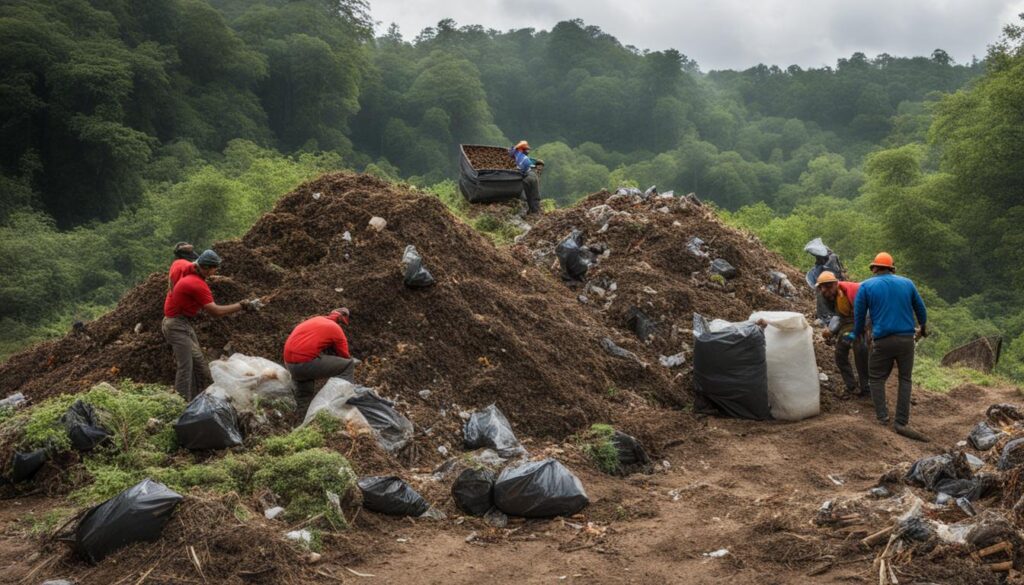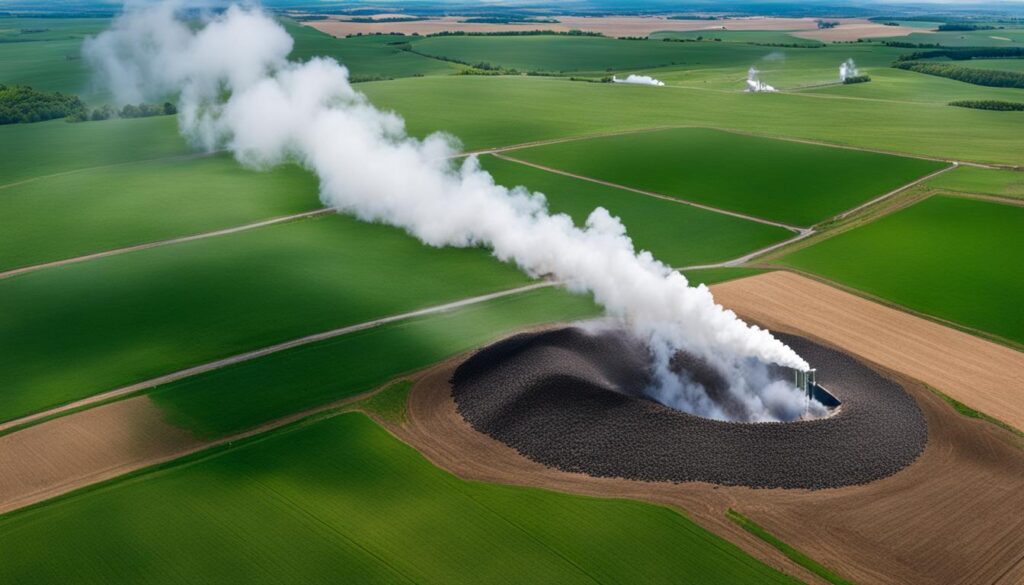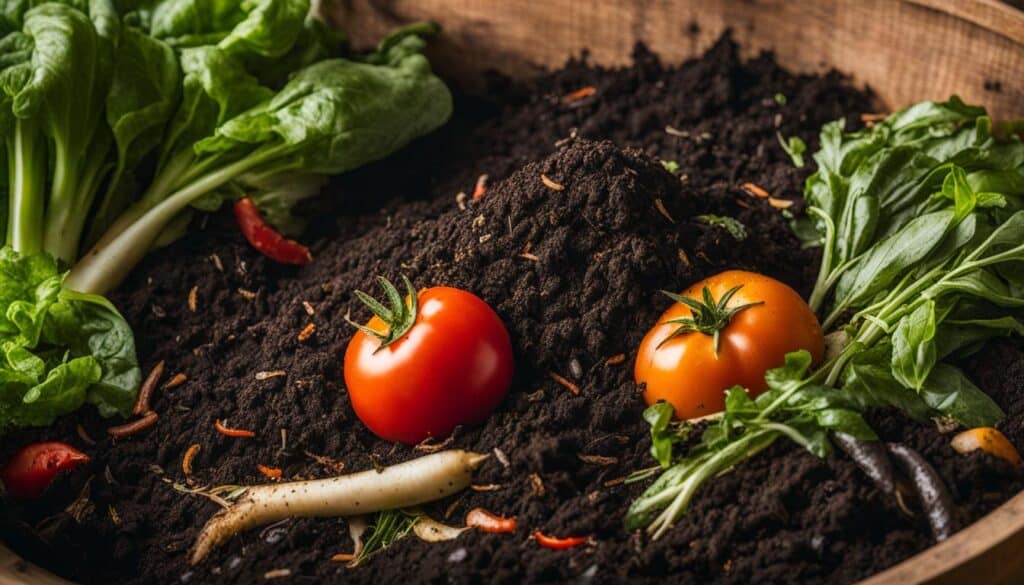Welcome to our article on windrow composting, a powerful method for transforming organic waste into nutrient-rich compost. By harnessing nature’s processes and carefully managing the composting process, windrow composting provides a sustainable and efficient solution for organic waste management.
Windrow composting involves building large piles, known as windrows, and layering organic materials such as farm residuals and livestock bedding. These windrows are then regularly turned or mixed to promote aerobic decomposition, allowing microorganisms to break down the organic materials and produce valuable compost. This natural process helps to reduce waste sent to landfills and provides numerous environmental benefits.
Throughout this article, we will explore the different aspects of windrow composting, including the composting process, best practices, environmental benefits, and challenges. So, let’s unlock the power of windrow composting and dive into this sustainable solution for organic waste management.
Key Takeaways:
- Windrow composting is a method for transforming organic waste into nutrient-rich compost.
- By building large piles, known as windrows, and managing the composting process, valuable compost can be produced.
- Aerobic decomposition, microbial activity, and optimal composting conditions are key to the windrow composting process.
- There are different types of windrow composting methods, including passive, turned, and in-vessel composting.
- Proper selection of composting materials, temperature control, and regular turning are essential for successful windrow composting.
Introduction to Windrow Composting
Windrow composting is a popular method used to manage organic waste. It involves creating long piles, or windrows, of compostable materials such as kitchen scraps, yard waste, agricultural byproducts, and livestock manure. These windrow piles are carefully managed to ensure proper composting conditions, including the ideal temperature and moisture levels.
The compost pile needs to be carefully constructed to allow for proper airflow and microbial activity. As the windrow is turned or mixed regularly, the internal temperature of the compost pile increases, promoting the breakdown of organic matter and the production of nutrient-rich compost. Regularly turning or mixing the windrow also ensures that oxygen is evenly distributed throughout the pile, facilitating aerobic decomposition and accelerating the breakdown of organic materials.
This has proven to be an effective and sustainable solution for managing organic waste. It provides an opportunity to recycle organic materials and reduce waste sent to landfills. By constructing and managing windrow piles, valuable compost can be produced, contributing to the improvement of soil health and fertility. With proper temperature and moisture control, alongside regular turning of the windrow pile, this method can unlock the power of nature and help create a more sustainable future.
Windrow Composting Process
Windrow composting relies on aerobic decomposition, which occurs in the presence of oxygen. This process involves carefully constructing windrows that allow for proper airflow and microbial activity. As the compost pile decomposes, microorganisms like bacteria and fungi break down the organic matter and release heat as a byproduct. This heat helps to maintain the optimal temperature range for composting, typically between 120-160 degrees Fahrenheit.
Regular turning or mixing of the windrow is crucial for promoting aerobic decomposition and accelerating the breakdown of organic materials. This turning action ensures that oxygen is evenly distributed throughout the pile, providing the necessary conditions for microbial activity to thrive. The microbial activity, in turn, continues the process of breaking down the organic matter, resulting in the production of nutrient-rich compost.
Utilizing this method, the compost pile undergoes several stages of decomposition. Initially, mesophilic microorganisms dominate the pile, and the temperature rises gradually. As the temperature increases, thermophilic microorganisms take over, driving the temperature even higher. This thermophilic stage is essential for killing pathogens and weed seeds present in the compost. Finally, as the organic matter breaks down further, the compost reaches a stable, mature state where it is ready to be used as a soil amendment.
Aerobic Decomposition in Windrow Composting
Aerobic decomposition is a critical aspect of windrow composting. It ensures that organic matter is broken down efficiently and that the resulting compost is of high quality. The presence of oxygen allows aerobic microorganisms to thrive and carry out the decomposition process effectively. These microorganisms require oxygen to perform their metabolic activities, releasing carbon dioxide and energy as they break down the organic matter.
“The windrow composting process relies on aerobic decomposition to transform organic waste into nutrient-rich compost. By creating an environment conducive to microbial activity and maintaining proper composting conditions, we can harness the power of nature to produce valuable soil amendments.”
The composting process is a dynamic one, with the temperature, oxygen levels, and moisture content all playing vital roles. Managing these factors ensures that the composting process proceeds smoothly, with minimal odor and a reduced risk of pathogens. By understanding and utilizing the principles of aerobic decomposition in composting, we can unlock nature’s power and create a sustainable solution for organic waste management.
Windrow Composting Types
When it comes to composting organic material, there are several different methods that can be used based on specific needs and available resources. Let’s explore the most common types of windrow composting and their unique characteristics.
1. Passive Windrow Composting
In passive composting, the focus is on simplicity and allowing nature to take its course. This method involves building a windrow pile using organic materials and then letting it naturally decompose over time. It requires minimal intervention and relies on ambient environmental factors, such as temperature and moisture, to facilitate the composting process. Passive windrow composting is often favored when there is limited access to equipment or resources for turning the windrow regularly.
2. Turned Windrow Composting
Turned windrow composting, as the name suggests, involves regularly turning or mixing the windrow pile to promote aerobic decomposition. This method ensures that oxygen is evenly distributed throughout the pile, creating optimal conditions for microbial activity and the breakdown of organic materials. By actively managing the windrow, the composting process can be accelerated, resulting in faster decomposition and the production of nutrient-rich compost.
3. In-Vessel Composting
In-vessel composting takes a more controlled approach by using specialized containers or structures to contain and manage the composting process. These vessels provide better insulation, temperature control, and odor management while allowing for efficient turning of the pile. This method is often preferred in situations where odor control or space limitations are a concern. It also allows for better control over composting conditions and can yield high-quality compost in a shorter period of time.
Each type of windrow composting method may require different composting recipes, which dictate the ratio of different organic materials used in the windrow pile. It’s important to consider factors such as the type of waste, available resources, and desired outcomes when selecting a windrow composting method and developing a composting recipe.
Table: Comparison of Windrow Composting Methods
| Method | Key Features | Benefits |
|---|---|---|
| Passive Windrow Composting | Minimal intervention, relies on natural decomposition | Low cost, suitable for limited resources |
| Turned Pile Composting | Regular turning/mixing for accelerated decomposition | Faster compost production, increased microbial activity |
| In-Vessel Composting | Controlled environment, better insulation and odor management | Improved temperature control, space efficiency |
By understanding the different types of windrow composting and their respective benefits, you can choose the most suitable approach for your specific needs. Whether you opt for a passive method or prefer the active management of turned pile composting or the controlled conditions of in-vessel composting, windrow composting offers a sustainable solution for transforming organic waste into valuable compost.
Best Practices for Windrow Composting

When it comes to windrow composting, following best practices is crucial to ensure successful and efficient composting. By implementing these practices, you can maximize the effectiveness of your windrow composting process and produce high-quality compost.
Selection of Composting Materials
The first step in pile composting is selecting the right materials for your compost pile. It is essential to maintain a balanced mix of carbon-rich materials and nitrogen-rich materials. Carbon-rich materials, also known as browns, provide structure and absorb moisture, while nitrogen-rich materials, also known as greens, provide nutrients for microbial activity. Examples of carbon-rich materials include dried leaves, straw, and wood chips, while nitrogen-rich materials include fresh grass clippings, food scraps, and manure. The ideal carbon-to-nitrogen ratio for windrow composting is between 25:1 and 30:1.
Monitoring Temperature and Moisture Levels
Proper temperature and moisture levels are crucial for the breakdown of organic matter and the activity of microorganisms in the compost pile. Monitoring the temperature of the windrow pile is essential to ensure that it remains within the range of 120-160 degrees Fahrenheit, as this is the optimal temperature for composting. Additionally, maintaining a moisture content of 40-60% is important to provide the right environment for microbial activity. Regularly monitoring temperature and moisture levels and making necessary adjustments will help ensure the success of your windrow composting process.
Regular Turning and Mixing of the Windrow Pile
To promote proper airflow and aerobic decomposition in the compost pile, it is important to regularly turn or mix the windrow. Turning or mixing the pile helps distribute oxygen throughout the windrow, which is necessary for the breakdown of organic matter. It also helps mix the composting materials, ensuring a more consistent composting process. Aim to turn the windrow at least once a week or whenever the internal temperature drops below the desired range. By incorporating regular turning or mixing into your windrow composting routine, you can accelerate the composting process and achieve faster results.
By following these best practices for windrow composting, you can optimize the composting process, produce high-quality compost, and contribute to a more sustainable approach to waste management.
Environmental Benefits of Windrow Composting
Windrow composting offers a range of environmental benefits that make it a sustainable choice for organic waste management. By diverting organic waste from landfills, windrow composting reduces methane emissions, a potent greenhouse gas that contributes to climate change. According to the United States Environmental Protection Agency (EPA), organic waste in landfills is the third-largest source of methane emissions in the country. By composting organic materials instead, we can significantly reduce these emissions and help combat climate change.
In addition to mitigating methane emissions, a composting pile produces nutrient-rich compost that improves soil health and fertility. This reduces the need for synthetic fertilizers, which often contain harmful chemicals that can pollute waterways and harm ecosystems. By using compost instead, we can provide the necessary nutrients to plants, while also preventing nutrient runoff and protecting our water resources.
Composting reduces methane emissions and produces nutrient-rich compost, contributing to climate change mitigation and improved soil health.
Furthermore, this method of composting promotes the recycling of organic materials, closing the loop in the waste management cycle. By composting organic waste, we turn it into a valuable resource that can be used to enrich soil, support plant growth, and contribute to a more sustainable agricultural system. This reduces the overall environmental impact of waste disposal and helps create a circular economy where resources are reused and recycled.
In summary, windrow composting offers significant environmental benefits, including the reduction of methane emissions, improved soil health, and the recycling of organic materials. By implementing these types of composting solutions , we can harness nature’s power to transform organic waste into a valuable resource while minimizing our impact on the environment.
Windrow Composting Challenges

While pile composting offers numerous benefits, there are some challenges that composting practitioners may face. It is important to be aware of these challenges and implement appropriate strategies to overcome them.
Offensive Odors
One challenge that can arise during this method of composting is the production of offensive odors. These odors can be a result of improper management of the compost pile, such as inadequate turning or mixing of the windrow and poor moisture control.
To mitigate odor issues, it is crucial to regularly turn or mix the windrow pile to ensure proper aeration and distribution of oxygen. This will help promote aerobic decomposition, which minimizes foul-smelling anaerobic conditions. Additionally, monitoring and maintaining the right moisture levels in the windrow pile can help prevent the formation of odor-causing compounds.
Pathogen Survival
Another challenge in windrow composting is the potential survival of thermotolerant pathogens, such as certain types of bacteria and fungi, in the compost pile.
To address this challenge, it is important to ensure that the windrow pile reaches and maintains the necessary temperatures for pathogen destruction. Monitoring and controlling composting temperatures within the range of 120-160 degrees Fahrenheit can help ensure the effective destruction of pathogens. Additionally, allowing sufficient time for complete composting can further reduce the risk of pathogen survival.
Vermin and Pest Control
The compost pile may attract vermin and pests, such as rodents and insects, which can be a challenge to manage during windrow composting.
To address this challenge, proper site management practices should be implemented. This includes securing the windrow pile to prevent easy access for vermin and pests. Implementing pest control measures, such as using traps or natural deterrents, can also help minimize the presence of unwanted animals and insects in the composting area.
Carbon to Nitrogen Ration
A fourth challenge lies in ensuring an appropriate carbon-to-nitrogen (C/N) ratio within the windrows for efficient decomposition. The C/N ratio affects microbial activity and plays a crucial role in maintaining an optimal balance between carbon-rich (high C/N) and nitrogen-rich (low C/N) materials.
Insufficient nitrogen content can slow down the decomposition process, resulting in longer composting times and subpar end products. To address this challenge, operators should carefully consider the composition of their feedstock materials.
Mixing high-carbon sources like straw or wood chips with nitrogen-rich materials such as food scraps or green waste can help achieve a desirable C/N ratio. Regular monitoring of the windrow’s C/N ratio and adjustments to the feedstock mix as needed are vital to ensure optimal conditions for microbial activity and efficient decomposition.
By being mindful of these challenges and implementing appropriate strategies, composting practitioners can effectively manage their compost piles and maximize the benefits of this sustainable waste management solutions.
Conclusion
Windrow composting offers a sustainable and efficient solution for managing organic waste. By carefully constructing and layering compost piles, we can harness the power of nature to transform waste into valuable compost. This process not only reduces the amount of waste sent to landfills, but also provides numerous environmental benefits.
Using this method of composting, we can contribute to a more sustainable future by reducing methane emissions and alleviating the strain on landfill capacity. The nutrient-rich compost produced can be used to improve soil health and fertility, reducing the need for synthetic fertilizers and preventing nutrient runoff into waterways.
While there may be challenges associated with all types of composting, such as offensive odors and the presence of thermotolerant pathogens, these can be addressed through proper management practices. By monitoring and controlling composting temperatures, ensuring adequate moisture levels, and implementing pest control measures, we can overcome these challenges and reap the rewards of windrow composting.
Embracing composting piles as a composting solution allows us to unlock the power of natures fertilizers. By following best practices, we can create a more sustainable and environmentally friendly approach to dealing with organic waste. Let us harness the potential of all types of composting to contribute to a greener, healthier planet.
FAQ
What is windrow composting?
Windrow composting is a method for transforming organic waste into nutrient-rich compost by building large piles, known as windrows, and carefully managing the composting process.
What materials can be used in a windrow compost pile?
Compostable materials such as kitchen scraps, yard waste, agricultural byproducts, and livestock manure can be used in a composting pile.
How does windrow composting work?
Composting piles rely on aerobic decomposition, where microorganisms break down organic matter in the presence of oxygen. The windrow is regularly turned or mixed to promote decomposition.
What are the different types of windrow composting methods?
The most common types of windrow composting methods include passive windrow composting, turned windrow composting, and in-vessel windrow composting.
What are the best practices for windrow composting?
Some best practices for this method include selecting the right composting materials, monitoring temperature and moisture levels, and regularly turning or mixing the compost pile.
What are the environmental benefits of windrow composting?
This type of composting reduces landfill waste, decreases methane emissions, improves soil health, reduces the need for synthetic fertilizers, and promotes the recycling of organic materials.
What are the challenges of windrow composting?
The challenges of this method can include offensive odors, potential survival of thermotolerant pathogens, and vermin and pest control.
How can windrow composting be a sustainable waste management solution?
This method provides a sustainable option by reducing waste sent to landfills, producing nutrient-rich compost, and closing the loop in the waste management cycle.



